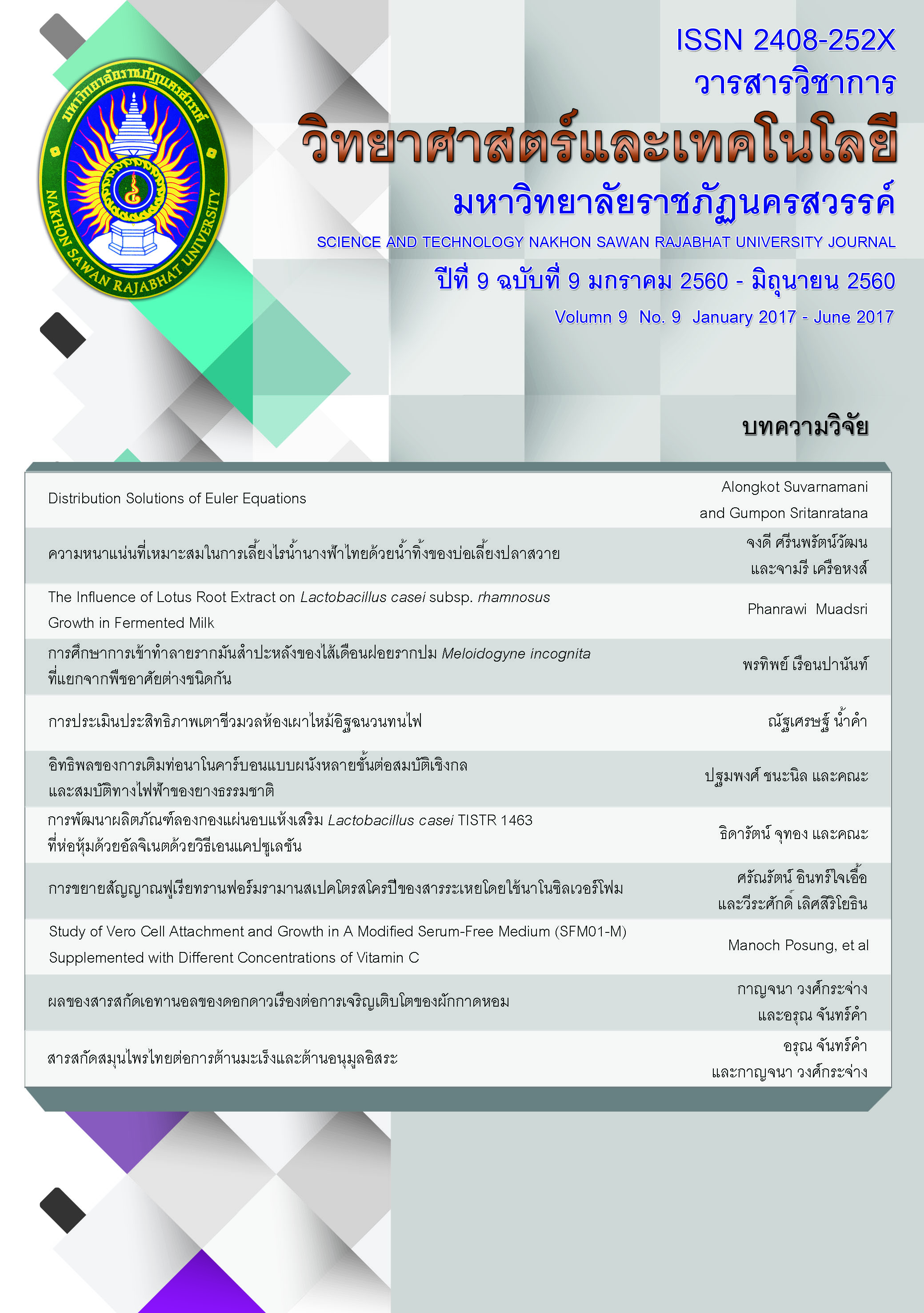การศึกษาการเข้าทำลายรากมันสำปะหลังของไส้เดือนฝอยรากปม Meloidogyne incognita ที่แยกจากพืชอาศัยต่างชนิดกัน
Main Article Content
บทคัดย่อ
จากการศึกษาการก่อโรคของไส้เดือนฝอยรากปม Meloidogyne incognita สาเหตุโรครากปมของมันสำปะหลังในพืชชนิดอื่น ได้แก่ ข้าว พริก มะเขือเทศ ขึ้นฉ่ายและถั่วเขียว พบว่าตัวอ่อนระยะที่ 2 ของ M. incognita จากมันสำปะหลัง (ไอโซเลต RKN1) สามารถก่อให้เกิดรากปมใน ข้าว พริก มะเขือเทศ ขึ้นฉ่ายและถั่วเขียว ในตรงกันข้ามไส้เดือนฝอย M. incognita ที่เข้าทำลายพริก (M. incognita ไอโซเลต RKN2) และข้าว (M. incognita ไอโซเลต RKN3) ไม่ก่อให้เกิดรากปมในมันสำปะหลัง และเมื่อนำตัวอ่อนระยะที่ 2 ของไส้เดือนฝอยรากปมไอโซเลต RKN1 รุ่นที่ 2 ที่แยกจากข้าว พริก มะเขือเทศ ขึ้นฉ่ายและถั่วเขียว ไปปลูกในมันสำปะหลังกลับอีกครั้งพบว่าไส้เดือนฝอยดังกล่าวไม่เข้าทำลายมันสำปะหลัง ในขณะที่ตัวอ่อนระยะที่ 2 ที่เจริญในรากมันสำปะหลังในทุกๆรุ่นยังคงความสามารถในการเข้าทำลายมันสำปะหลังได้ดังเดิม ผลการวิจัยนี้ชี้ให้เห็นว่า ข้าว พริก มะเขือเทศ ขึ้นฉ่ายและถั่วเขียวซึ่งเป็นพืชอาศัยของไส้เดือนฝอย M. incognita มีผลต่อความสามารถในการเข้าทำลายรากมันสำปะหลังของไส้เดือนฝอยรากปม M. incognita ไอโซเลต RKN1 และไส้เดือนฝอยไอโซเลตที่เข้าทำลายพริก (RKN2) และข้าว (RKN3) ไม่ก่อให้เกิดโรครากปมในมันสำปะหลัง ผลการทดลองนี้ถือเป็นข้อมูลพื้นฐานที่สำคัญในการนำไปใช้เพื่อการควบคุมและจัดการไส้เดือนฝอยรากปมในแปลงเกษตรต่อไป
Article Details
เอกสารอ้างอิง
ลาภิสรา วงศ์แก้ว สุทธินี ลิขิตตระกูลรุ่ง นิสิต บุญเป็ง และสตรีรัตน์ ใหม่ตา. 2554. ตามรอยอีพบปม. สำนักวิจัยและพัฒนาการเกษตรเขตที่ 1 www.oard1.org (28 มกราคม 2560)
Barker, K.R.,1985. Nematode extraction and bioassays. In: Barker, K.R., Carter, C.C., Sasser, J.N. (eds), An advanced treatise on Meloidogyne, vol II., North Carolina State University GraphicsRaleigh, NC, pp 29–30.
Byrd, D.W.J, Kirkpatrick, T., Barker, K.R., 1983. An improved technique for clearing and staining plant tissue for detection of nematodes. J Nematol. 14, 142-143.
Caveness, F.E., 1982. Root-knot nematodes as parasites of cassava. IITA Research Briefs. 3, 2-3.
Caillaud, M.C., Dubreuil, G., Quentin, M., Perfus-Barbeoch, L., Lecomte, P. et al. (2008). Root-knot nematodes manipulate plant cell functions during a compatible interaction. J Plant Physiol. 165, 104-113.
Das, S., DeMason, D.A., Ehlers, J.D., Close, T.J., Roberts, P.A., 2008. Histological characterization of root-knot nematode resistance in cowpea and its relation to reactive oxygen species modulation. J Exp Bot. 59, 1305-1313.
Decker, H., Fritzsche, R., 1991. Resistenz von Kulturpflanzen gegen Nematoden. Akademie Verlag, Berlin
Devran, Z., Söğüt, M.A., 2011. Characterizing races of Meloidogyne incognita, M. javanica and M. arenaria in the West Mediterranean region of Turkey. Crop Prot. 30,451-455.
Eisenback, D.E., Triantaphyllou, H.H., 1991. Root-knot nematodes: Meloidogyne species and races. In: Nickle, W.R. (ed.), Manual of agricultural nematology. Marcel Dekker Inc., New York, pp. 191-274.
Fervary, D., Quentin, M., Jaubert-Possamai, S., Abad, P., 2016. Gall-forming root-knot nematodes hijack key plant cellular functions to induce multinucleate and hypertrophied feeding cells. J. Insect Physiol. 84, 60-69.
Handoo, Z.A., Skantar, A.M., Carta, L.A., Erbe, E.F., 2005. Morphological and molecular characterization of a new root-knot nematode, Meloidogyne thailandica n. sp. (Nematoda: Meloidogynidae), parasitizing ginger (Zingiber sp.). J Nematol. 37, 343-353.
Hunt, D.J., Handoo, Z.A., 2009. Taxonomy identification and principal species. In: Perry, R.N., Moens, M., Starr, J.L. (eds), Root-knot nematodes. CABI publishing, Wallingford pp. 55-97.
Hartman, K.M., Sasser, J.N., 1985. Identification of Meloidogyne species on the basis of differential host test and perineal pattern morphology. In: Barker, K.R., Carter, C.C., Sasser, J.N. (eds.), An Advanced Treatise on Meloidogyne. Methodology, vol. II. North Carolina State University Graphics, North Carolina, pp. 69-77.
Johnson, C.S., 1998. Tobacco. In: Barker, K.R., Pederson, G.A., Windham, G.L. (eds), Plant and nematode interactions. American Society of Agronomists, Madison, pp. 487-521.
Lertsuchatavanich, U. (2011). Root gall disease: another important threat in cassava plantation. Kahakaset (House Agricultural Magazine) 35, 99-101.
Netscher, C., Sikora, R.A., 1990. Nematode parasites of vegetables. In: Luc, M.,Sikora, R.A., Bridge, J. (eds.), Plant parasitic nematodes in subtropical and tropical agriculture. CAB International, Wallingford, Oxon, pp. 237-283.
Ruanpanun, P., Khun-In, A., 2015. First report of Meloidogyne incognita caused root knot disease of upland rice in Thailand. J ISSAAS. 21, 68-77.
Ruanpanun, P., Tangchitsomkid, N., Hyde, K.D., Lumyong, S., 2010. Actinomycetes and fungi isolated from plant-parasitic nematode infested soils: screening of the effective biocontrol potential, indole-3-acetic acid and siderophore production. World J Microbiol Biotechnol. 26, 1569-1578.
Ruanpanun, P., Chamswarng, C., 2016. Potential of actinomycetes isolated from earthworm castings in controlling root-knot nematode Meloidogyne incognita. J Gen Plant Pathol. 82, 43-50.
Stirling, G.R., Berthelsen, J.E., Garside, A.L., James, A.T., 2006. The reaction of soybean and other legume crops to root-knot nematode (Meloidogyne spp.), and implications for growing these crops in rotation with sugarcane. Australas Plant Pathol. 35, 707-714.
Sun, M.H., Gao, L., Shi, Y.X., Li. B., Liu, X.Z., 2006. Fungi and actinomycetes associated with Meloidogyne spp. eggs and females in China and their biocontrol potential. J Invertebr Pathol. 93, 22-28.
Robertson, L., Díez-Rojo, M.A., López-Pérez, J.A., Piedra Buena, A., Escuer, M.,López Cepero, J., Martínez, C., Bello, A., 2009. A. New host races of Meloidogyne arenaria, M. incognita and M. javanica from horticultural regions of Spain. Plant Dis. 93, 180-184.
Theberge, R. L., 1985. Common African pests and disease of cassava, yam sweet potato, cocoyam. International Institute of Tropical Agriculture Ibadan, Nigeria. 108p.


